Evaluating Public Health Interventions: Strategies and Effectiveness
VerifiedAdded on 2023/06/17
|10
|2847
|481
Report
AI Summary
This report provides a comprehensive evaluation of public health interventions, exploring various types such as screening programs, vaccinations, food and water supplementation, and health promotion strategies. It assesses how these interventions lead to measurable health improvements at local and national levels, addressing the challenges to enabling effective interventions, including public support, legal compliance, and workforce shortages. The report describes strategies aimed at reducing disease incidence in local communities, such as primordial, primary, secondary, tertiary, and quaternary prevention. It explains the role of statutory bodies in developing health protection strategies and analyzes the effectiveness of health promotion strategies in preventing disease. Furthermore, it critically examines the effectiveness of nationwide health protection strategies in reducing health inequalities, highlighting the interventions implemented by Public Health England. The conclusion summarizes the key findings, emphasizing the importance of integrated and targeted interventions for improving public health outcomes and reducing inequalities.
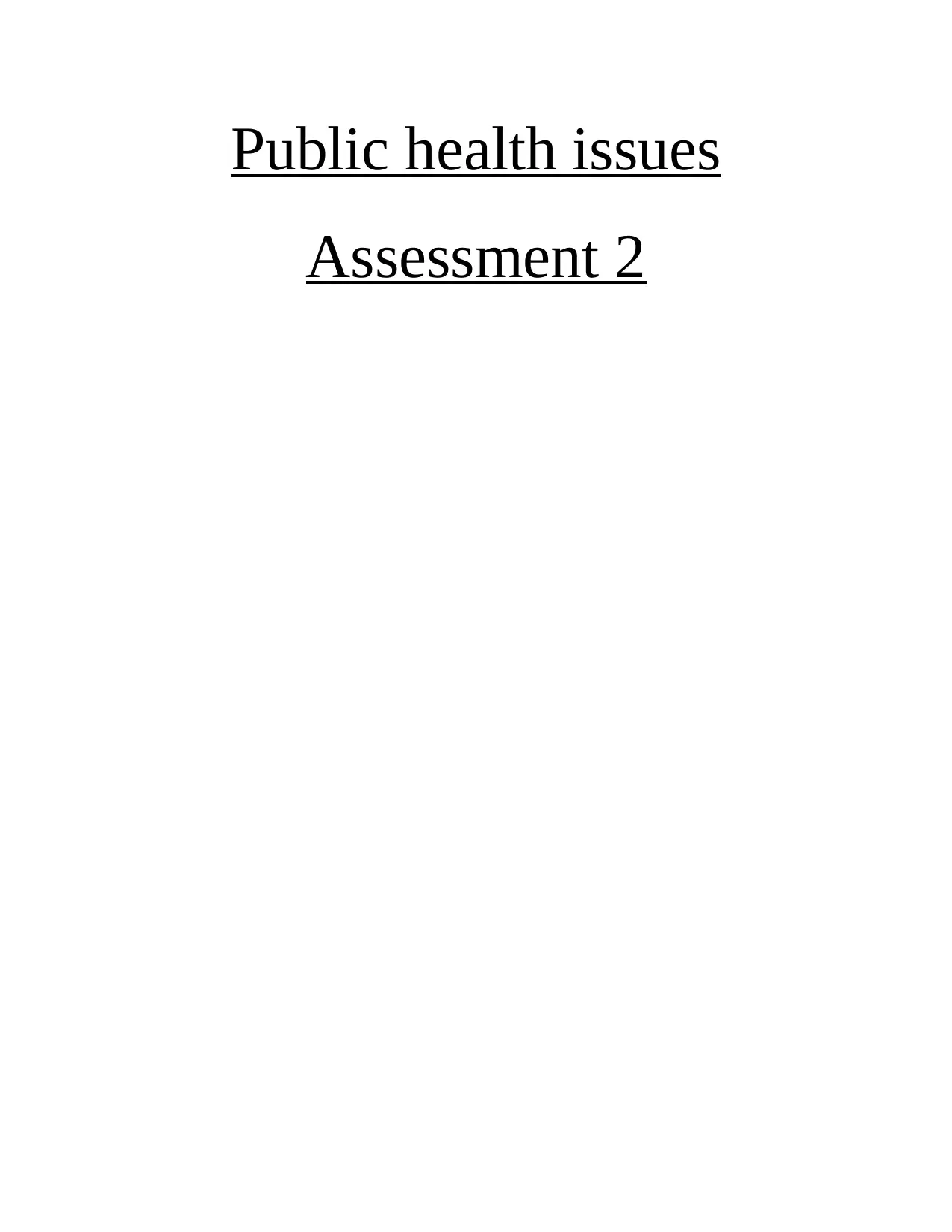
Public health issues
Assessment 2
Assessment 2
Paraphrase This Document
Need a fresh take? Get an instant paraphrase of this document with our AI Paraphraser
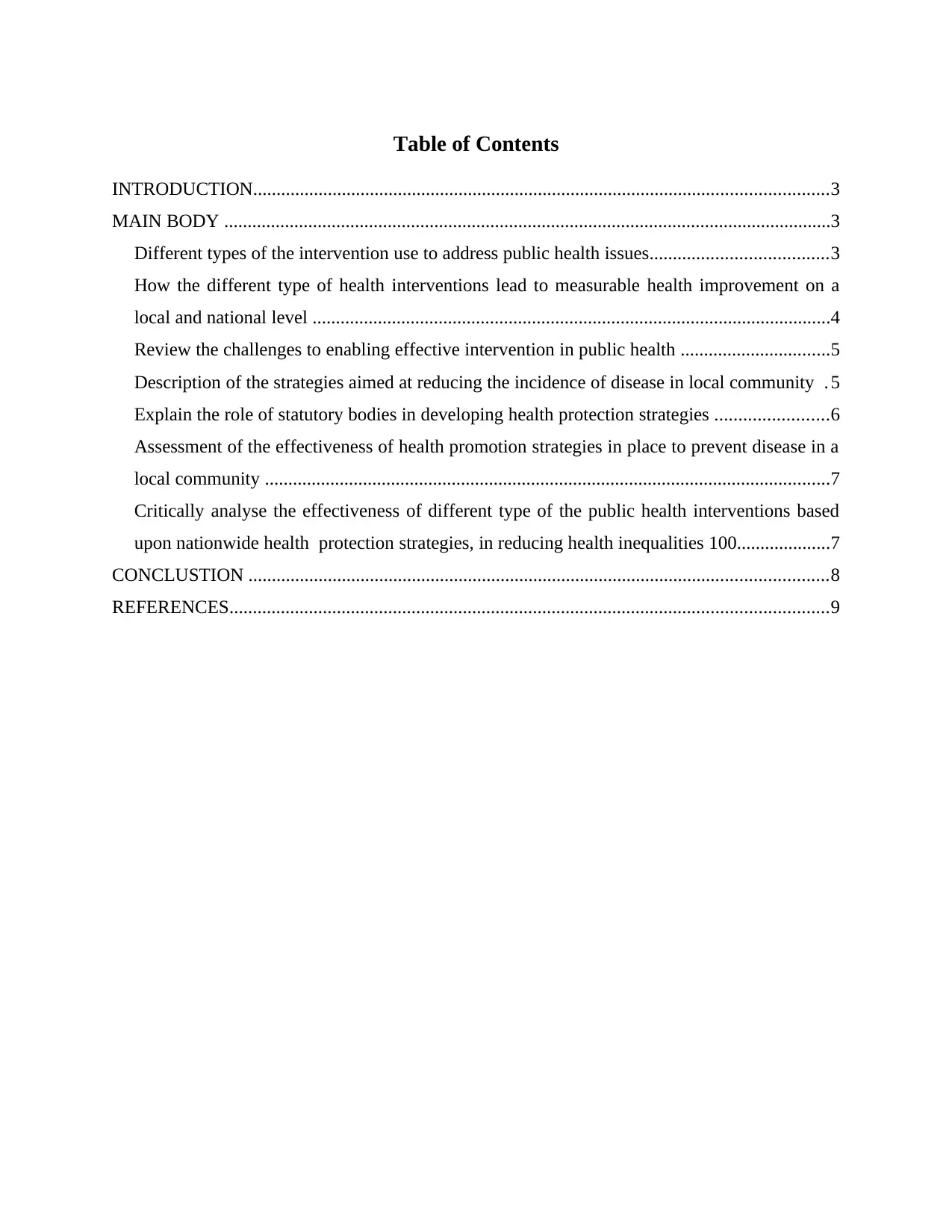
Table of Contents
INTRODUCTION...........................................................................................................................3
MAIN BODY ..................................................................................................................................3
Different types of the intervention use to address public health issues......................................3
How the different type of health interventions lead to measurable health improvement on a
local and national level ...............................................................................................................4
Review the challenges to enabling effective intervention in public health ................................5
Description of the strategies aimed at reducing the incidence of disease in local community . 5
Explain the role of statutory bodies in developing health protection strategies ........................6
Assessment of the effectiveness of health promotion strategies in place to prevent disease in a
local community .........................................................................................................................7
Critically analyse the effectiveness of different type of the public health interventions based
upon nationwide health protection strategies, in reducing health inequalities 100....................7
CONCLUSTION ............................................................................................................................8
REFERENCES................................................................................................................................9
INTRODUCTION...........................................................................................................................3
MAIN BODY ..................................................................................................................................3
Different types of the intervention use to address public health issues......................................3
How the different type of health interventions lead to measurable health improvement on a
local and national level ...............................................................................................................4
Review the challenges to enabling effective intervention in public health ................................5
Description of the strategies aimed at reducing the incidence of disease in local community . 5
Explain the role of statutory bodies in developing health protection strategies ........................6
Assessment of the effectiveness of health promotion strategies in place to prevent disease in a
local community .........................................................................................................................7
Critically analyse the effectiveness of different type of the public health interventions based
upon nationwide health protection strategies, in reducing health inequalities 100....................7
CONCLUSTION ............................................................................................................................8
REFERENCES................................................................................................................................9
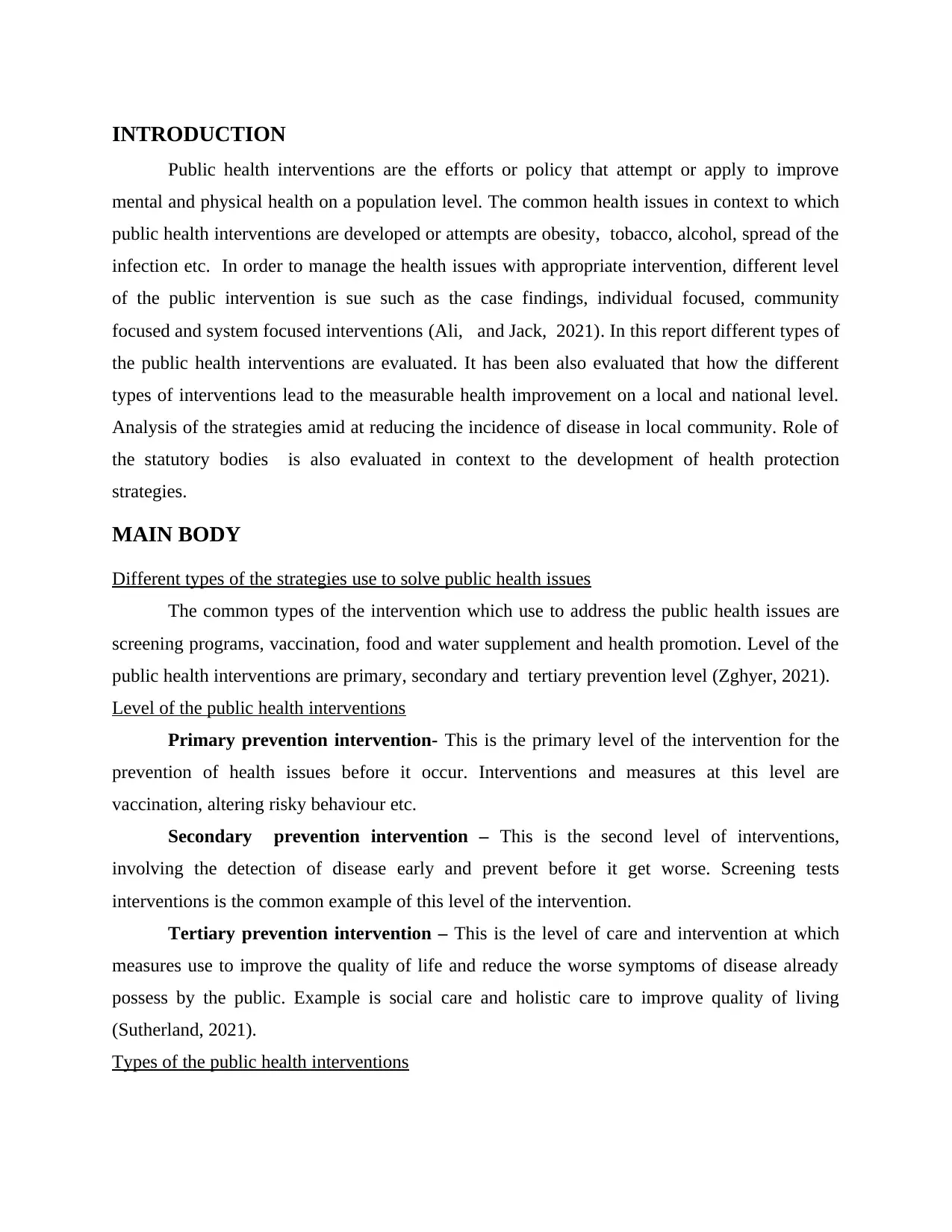
INTRODUCTION
Public health interventions are the efforts or policy that attempt or apply to improve
mental and physical health on a population level. The common health issues in context to which
public health interventions are developed or attempts are obesity, tobacco, alcohol, spread of the
infection etc. In order to manage the health issues with appropriate intervention, different level
of the public intervention is sue such as the case findings, individual focused, community
focused and system focused interventions (Ali, and Jack, 2021). In this report different types of
the public health interventions are evaluated. It has been also evaluated that how the different
types of interventions lead to the measurable health improvement on a local and national level.
Analysis of the strategies amid at reducing the incidence of disease in local community. Role of
the statutory bodies is also evaluated in context to the development of health protection
strategies.
MAIN BODY
Different types of the strategies use to solve public health issues
The common types of the intervention which use to address the public health issues are
screening programs, vaccination, food and water supplement and health promotion. Level of the
public health interventions are primary, secondary and tertiary prevention level (Zghyer, 2021).
Level of the public health interventions
Primary prevention intervention- This is the primary level of the intervention for the
prevention of health issues before it occur. Interventions and measures at this level are
vaccination, altering risky behaviour etc.
Secondary prevention intervention – This is the second level of interventions,
involving the detection of disease early and prevent before it get worse. Screening tests
interventions is the common example of this level of the intervention.
Tertiary prevention intervention – This is the level of care and intervention at which
measures use to improve the quality of life and reduce the worse symptoms of disease already
possess by the public. Example is social care and holistic care to improve quality of living
(Sutherland, 2021).
Types of the public health interventions
Public health interventions are the efforts or policy that attempt or apply to improve
mental and physical health on a population level. The common health issues in context to which
public health interventions are developed or attempts are obesity, tobacco, alcohol, spread of the
infection etc. In order to manage the health issues with appropriate intervention, different level
of the public intervention is sue such as the case findings, individual focused, community
focused and system focused interventions (Ali, and Jack, 2021). In this report different types of
the public health interventions are evaluated. It has been also evaluated that how the different
types of interventions lead to the measurable health improvement on a local and national level.
Analysis of the strategies amid at reducing the incidence of disease in local community. Role of
the statutory bodies is also evaluated in context to the development of health protection
strategies.
MAIN BODY
Different types of the strategies use to solve public health issues
The common types of the intervention which use to address the public health issues are
screening programs, vaccination, food and water supplement and health promotion. Level of the
public health interventions are primary, secondary and tertiary prevention level (Zghyer, 2021).
Level of the public health interventions
Primary prevention intervention- This is the primary level of the intervention for the
prevention of health issues before it occur. Interventions and measures at this level are
vaccination, altering risky behaviour etc.
Secondary prevention intervention – This is the second level of interventions,
involving the detection of disease early and prevent before it get worse. Screening tests
interventions is the common example of this level of the intervention.
Tertiary prevention intervention – This is the level of care and intervention at which
measures use to improve the quality of life and reduce the worse symptoms of disease already
possess by the public. Example is social care and holistic care to improve quality of living
(Sutherland, 2021).
Types of the public health interventions
⊘ This is a preview!⊘
Do you want full access?
Subscribe today to unlock all pages.

Trusted by 1+ million students worldwide
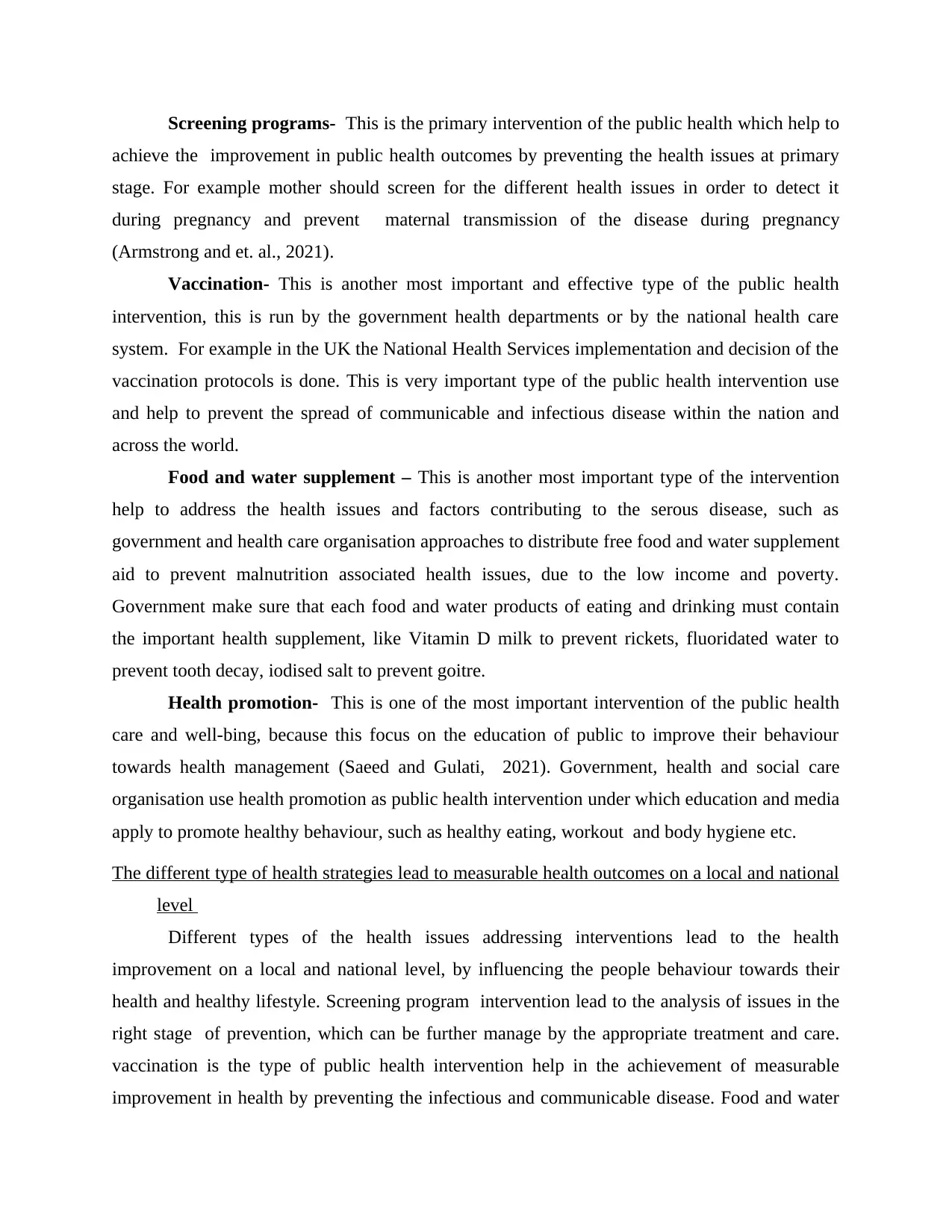
Screening programs- This is the primary intervention of the public health which help to
achieve the improvement in public health outcomes by preventing the health issues at primary
stage. For example mother should screen for the different health issues in order to detect it
during pregnancy and prevent maternal transmission of the disease during pregnancy
(Armstrong and et. al., 2021).
Vaccination- This is another most important and effective type of the public health
intervention, this is run by the government health departments or by the national health care
system. For example in the UK the National Health Services implementation and decision of the
vaccination protocols is done. This is very important type of the public health intervention use
and help to prevent the spread of communicable and infectious disease within the nation and
across the world.
Food and water supplement – This is another most important type of the intervention
help to address the health issues and factors contributing to the serous disease, such as
government and health care organisation approaches to distribute free food and water supplement
aid to prevent malnutrition associated health issues, due to the low income and poverty.
Government make sure that each food and water products of eating and drinking must contain
the important health supplement, like Vitamin D milk to prevent rickets, fluoridated water to
prevent tooth decay, iodised salt to prevent goitre.
Health promotion- This is one of the most important intervention of the public health
care and well-bing, because this focus on the education of public to improve their behaviour
towards health management (Saeed and Gulati, 2021). Government, health and social care
organisation use health promotion as public health intervention under which education and media
apply to promote healthy behaviour, such as healthy eating, workout and body hygiene etc.
The different type of health strategies lead to measurable health outcomes on a local and national
level
Different types of the health issues addressing interventions lead to the health
improvement on a local and national level, by influencing the people behaviour towards their
health and healthy lifestyle. Screening program intervention lead to the analysis of issues in the
right stage of prevention, which can be further manage by the appropriate treatment and care.
vaccination is the type of public health intervention help in the achievement of measurable
improvement in health by preventing the infectious and communicable disease. Food and water
achieve the improvement in public health outcomes by preventing the health issues at primary
stage. For example mother should screen for the different health issues in order to detect it
during pregnancy and prevent maternal transmission of the disease during pregnancy
(Armstrong and et. al., 2021).
Vaccination- This is another most important and effective type of the public health
intervention, this is run by the government health departments or by the national health care
system. For example in the UK the National Health Services implementation and decision of the
vaccination protocols is done. This is very important type of the public health intervention use
and help to prevent the spread of communicable and infectious disease within the nation and
across the world.
Food and water supplement – This is another most important type of the intervention
help to address the health issues and factors contributing to the serous disease, such as
government and health care organisation approaches to distribute free food and water supplement
aid to prevent malnutrition associated health issues, due to the low income and poverty.
Government make sure that each food and water products of eating and drinking must contain
the important health supplement, like Vitamin D milk to prevent rickets, fluoridated water to
prevent tooth decay, iodised salt to prevent goitre.
Health promotion- This is one of the most important intervention of the public health
care and well-bing, because this focus on the education of public to improve their behaviour
towards health management (Saeed and Gulati, 2021). Government, health and social care
organisation use health promotion as public health intervention under which education and media
apply to promote healthy behaviour, such as healthy eating, workout and body hygiene etc.
The different type of health strategies lead to measurable health outcomes on a local and national
level
Different types of the health issues addressing interventions lead to the health
improvement on a local and national level, by influencing the people behaviour towards their
health and healthy lifestyle. Screening program intervention lead to the analysis of issues in the
right stage of prevention, which can be further manage by the appropriate treatment and care.
vaccination is the type of public health intervention help in the achievement of measurable
improvement in health by preventing the infectious and communicable disease. Food and water
Paraphrase This Document
Need a fresh take? Get an instant paraphrase of this document with our AI Paraphraser
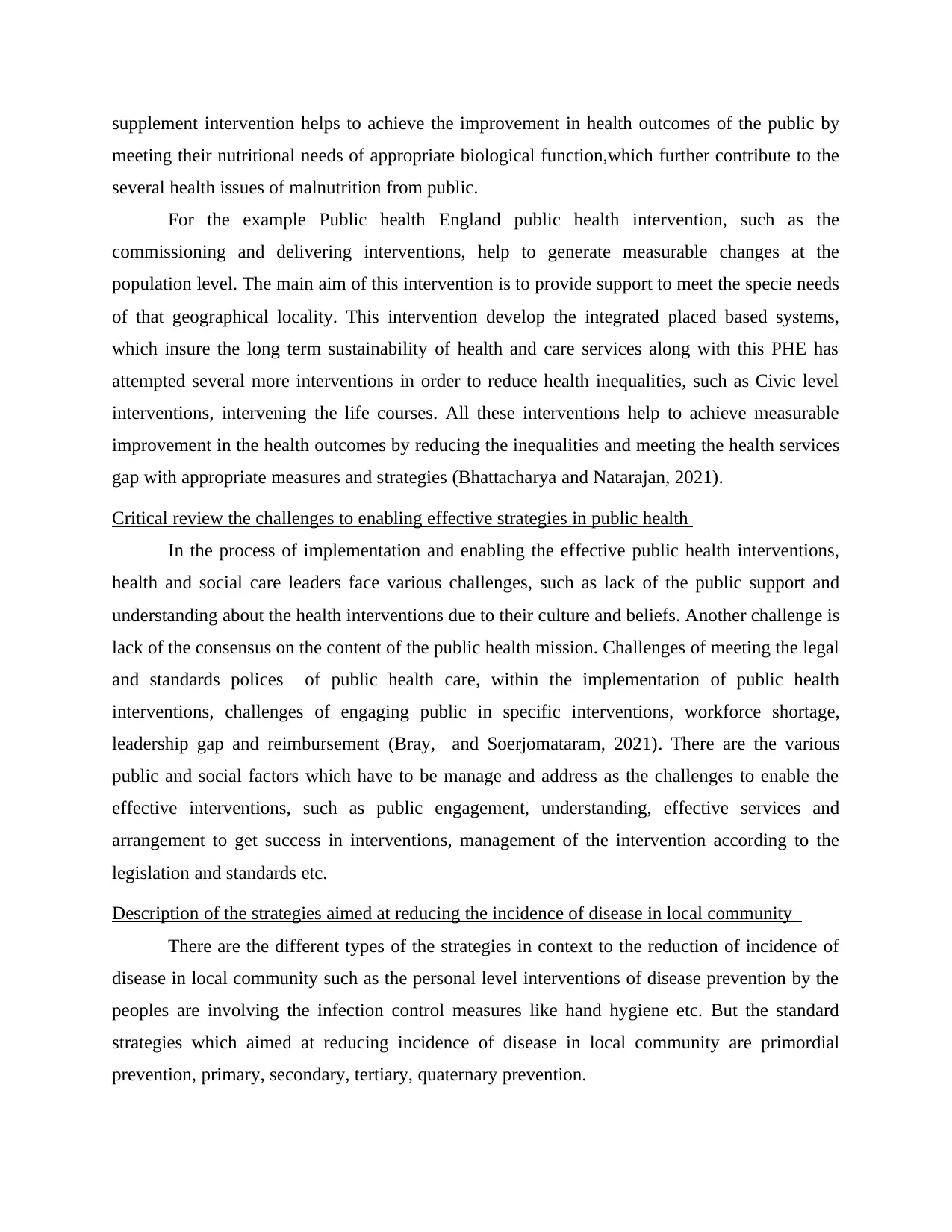
supplement intervention helps to achieve the improvement in health outcomes of the public by
meeting their nutritional needs of appropriate biological function,which further contribute to the
several health issues of malnutrition from public.
For the example Public health England public health intervention, such as the
commissioning and delivering interventions, help to generate measurable changes at the
population level. The main aim of this intervention is to provide support to meet the specie needs
of that geographical locality. This intervention develop the integrated placed based systems,
which insure the long term sustainability of health and care services along with this PHE has
attempted several more interventions in order to reduce health inequalities, such as Civic level
interventions, intervening the life courses. All these interventions help to achieve measurable
improvement in the health outcomes by reducing the inequalities and meeting the health services
gap with appropriate measures and strategies (Bhattacharya and Natarajan, 2021).
Critical review the challenges to enabling effective strategies in public health
In the process of implementation and enabling the effective public health interventions,
health and social care leaders face various challenges, such as lack of the public support and
understanding about the health interventions due to their culture and beliefs. Another challenge is
lack of the consensus on the content of the public health mission. Challenges of meeting the legal
and standards polices of public health care, within the implementation of public health
interventions, challenges of engaging public in specific interventions, workforce shortage,
leadership gap and reimbursement (Bray, and Soerjomataram, 2021). There are the various
public and social factors which have to be manage and address as the challenges to enable the
effective interventions, such as public engagement, understanding, effective services and
arrangement to get success in interventions, management of the intervention according to the
legislation and standards etc.
Description of the strategies aimed at reducing the incidence of disease in local community
There are the different types of the strategies in context to the reduction of incidence of
disease in local community such as the personal level interventions of disease prevention by the
peoples are involving the infection control measures like hand hygiene etc. But the standard
strategies which aimed at reducing incidence of disease in local community are primordial
prevention, primary, secondary, tertiary, quaternary prevention.
meeting their nutritional needs of appropriate biological function,which further contribute to the
several health issues of malnutrition from public.
For the example Public health England public health intervention, such as the
commissioning and delivering interventions, help to generate measurable changes at the
population level. The main aim of this intervention is to provide support to meet the specie needs
of that geographical locality. This intervention develop the integrated placed based systems,
which insure the long term sustainability of health and care services along with this PHE has
attempted several more interventions in order to reduce health inequalities, such as Civic level
interventions, intervening the life courses. All these interventions help to achieve measurable
improvement in the health outcomes by reducing the inequalities and meeting the health services
gap with appropriate measures and strategies (Bhattacharya and Natarajan, 2021).
Critical review the challenges to enabling effective strategies in public health
In the process of implementation and enabling the effective public health interventions,
health and social care leaders face various challenges, such as lack of the public support and
understanding about the health interventions due to their culture and beliefs. Another challenge is
lack of the consensus on the content of the public health mission. Challenges of meeting the legal
and standards polices of public health care, within the implementation of public health
interventions, challenges of engaging public in specific interventions, workforce shortage,
leadership gap and reimbursement (Bray, and Soerjomataram, 2021). There are the various
public and social factors which have to be manage and address as the challenges to enable the
effective interventions, such as public engagement, understanding, effective services and
arrangement to get success in interventions, management of the intervention according to the
legislation and standards etc.
Description of the strategies aimed at reducing the incidence of disease in local community
There are the different types of the strategies in context to the reduction of incidence of
disease in local community such as the personal level interventions of disease prevention by the
peoples are involving the infection control measures like hand hygiene etc. But the standard
strategies which aimed at reducing incidence of disease in local community are primordial
prevention, primary, secondary, tertiary, quaternary prevention.
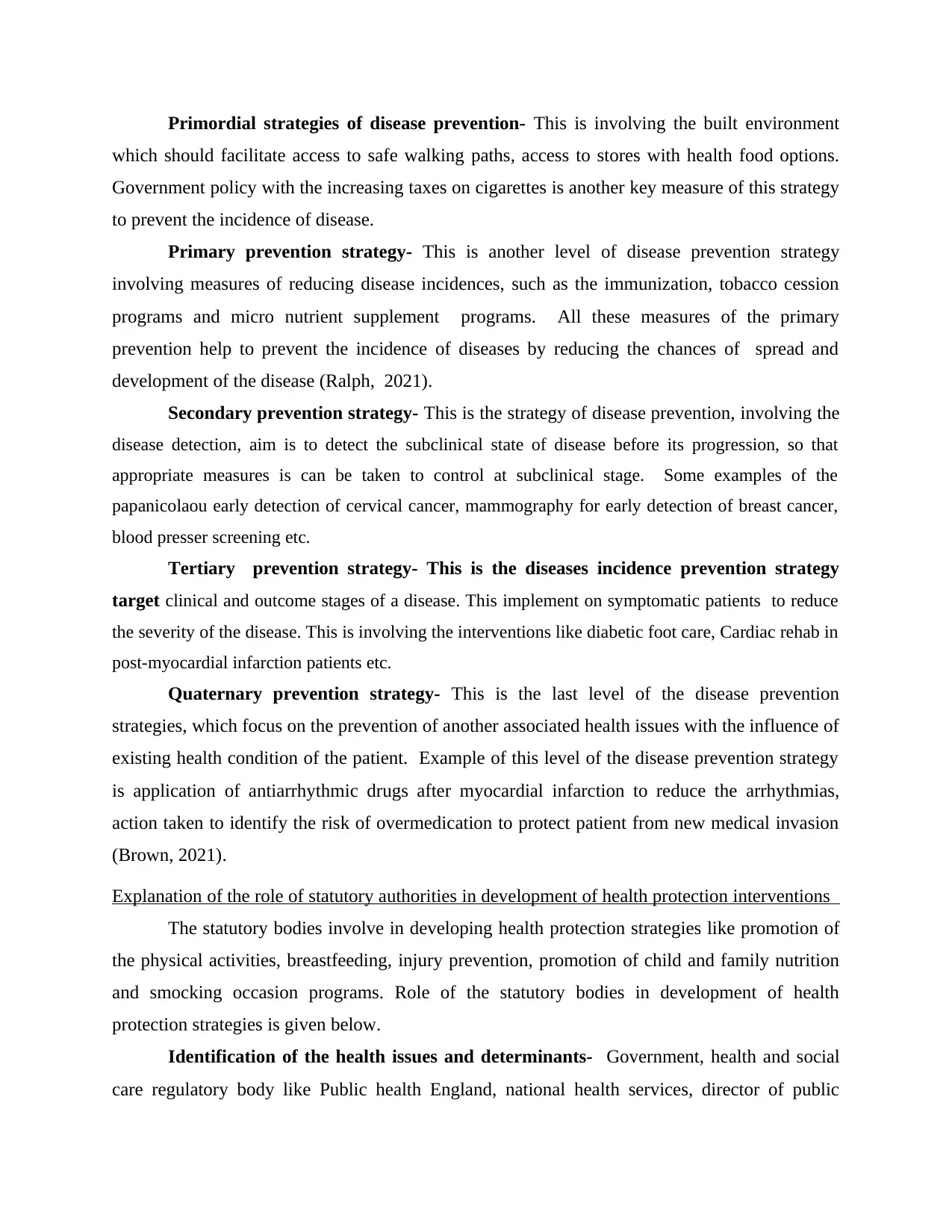
Primordial strategies of disease prevention- This is involving the built environment
which should facilitate access to safe walking paths, access to stores with health food options.
Government policy with the increasing taxes on cigarettes is another key measure of this strategy
to prevent the incidence of disease.
Primary prevention strategy- This is another level of disease prevention strategy
involving measures of reducing disease incidences, such as the immunization, tobacco cession
programs and micro nutrient supplement programs. All these measures of the primary
prevention help to prevent the incidence of diseases by reducing the chances of spread and
development of the disease (Ralph, 2021).
Secondary prevention strategy- This is the strategy of disease prevention, involving the
disease detection, aim is to detect the subclinical state of disease before its progression, so that
appropriate measures is can be taken to control at subclinical stage. Some examples of the
papanicolaou early detection of cervical cancer, mammography for early detection of breast cancer,
blood presser screening etc.
Tertiary prevention strategy- This is the diseases incidence prevention strategy
target clinical and outcome stages of a disease. This implement on symptomatic patients to reduce
the severity of the disease. This is involving the interventions like diabetic foot care, Cardiac rehab in
post-myocardial infarction patients etc.
Quaternary prevention strategy- This is the last level of the disease prevention
strategies, which focus on the prevention of another associated health issues with the influence of
existing health condition of the patient. Example of this level of the disease prevention strategy
is application of antiarrhythmic drugs after myocardial infarction to reduce the arrhythmias,
action taken to identify the risk of overmedication to protect patient from new medical invasion
(Brown, 2021).
Explanation of the role of statutory authorities in development of health protection interventions
The statutory bodies involve in developing health protection strategies like promotion of
the physical activities, breastfeeding, injury prevention, promotion of child and family nutrition
and smocking occasion programs. Role of the statutory bodies in development of health
protection strategies is given below.
Identification of the health issues and determinants- Government, health and social
care regulatory body like Public health England, national health services, director of public
which should facilitate access to safe walking paths, access to stores with health food options.
Government policy with the increasing taxes on cigarettes is another key measure of this strategy
to prevent the incidence of disease.
Primary prevention strategy- This is another level of disease prevention strategy
involving measures of reducing disease incidences, such as the immunization, tobacco cession
programs and micro nutrient supplement programs. All these measures of the primary
prevention help to prevent the incidence of diseases by reducing the chances of spread and
development of the disease (Ralph, 2021).
Secondary prevention strategy- This is the strategy of disease prevention, involving the
disease detection, aim is to detect the subclinical state of disease before its progression, so that
appropriate measures is can be taken to control at subclinical stage. Some examples of the
papanicolaou early detection of cervical cancer, mammography for early detection of breast cancer,
blood presser screening etc.
Tertiary prevention strategy- This is the diseases incidence prevention strategy
target clinical and outcome stages of a disease. This implement on symptomatic patients to reduce
the severity of the disease. This is involving the interventions like diabetic foot care, Cardiac rehab in
post-myocardial infarction patients etc.
Quaternary prevention strategy- This is the last level of the disease prevention
strategies, which focus on the prevention of another associated health issues with the influence of
existing health condition of the patient. Example of this level of the disease prevention strategy
is application of antiarrhythmic drugs after myocardial infarction to reduce the arrhythmias,
action taken to identify the risk of overmedication to protect patient from new medical invasion
(Brown, 2021).
Explanation of the role of statutory authorities in development of health protection interventions
The statutory bodies involve in developing health protection strategies like promotion of
the physical activities, breastfeeding, injury prevention, promotion of child and family nutrition
and smocking occasion programs. Role of the statutory bodies in development of health
protection strategies is given below.
Identification of the health issues and determinants- Government, health and social
care regulatory body like Public health England, national health services, director of public
⊘ This is a preview!⊘
Do you want full access?
Subscribe today to unlock all pages.

Trusted by 1+ million students worldwide
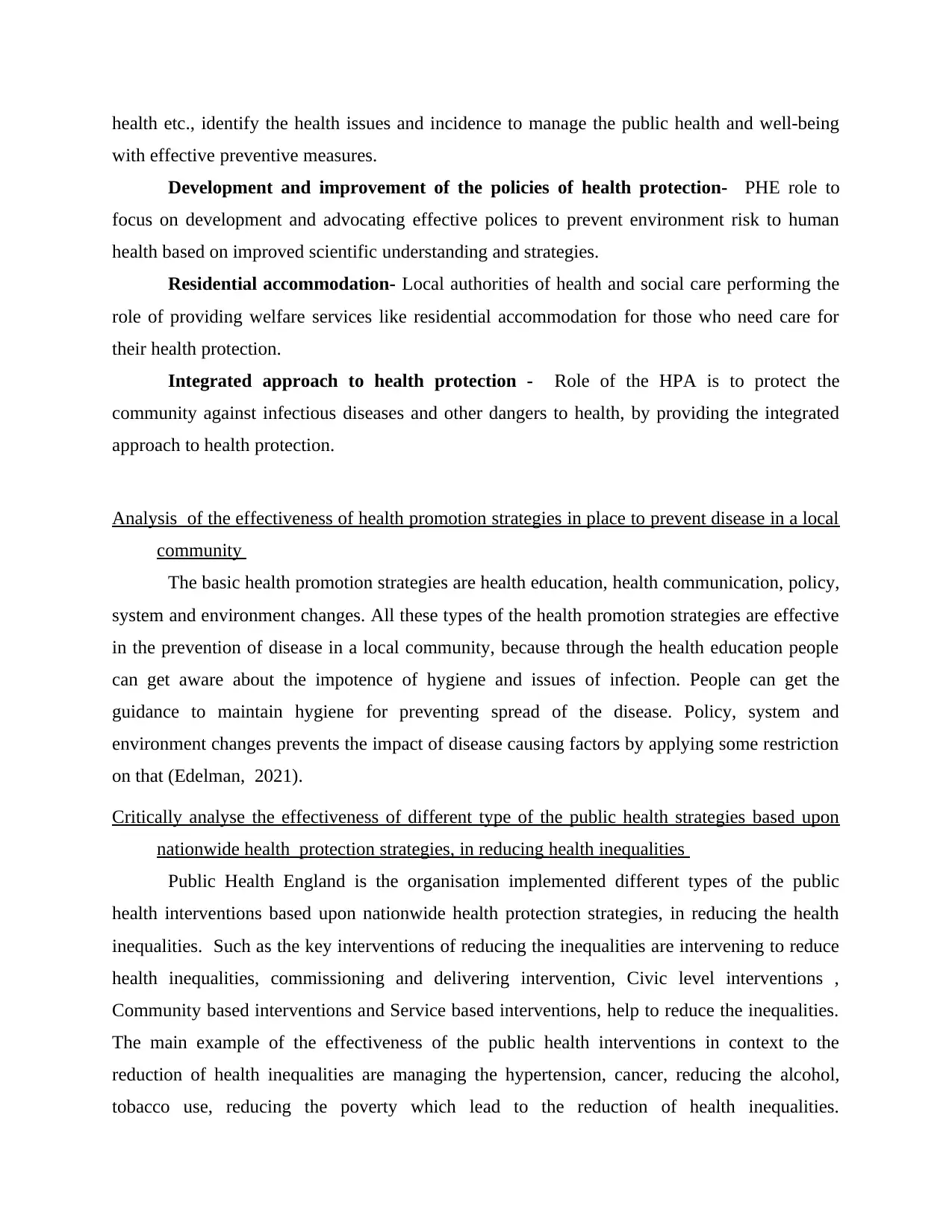
health etc., identify the health issues and incidence to manage the public health and well-being
with effective preventive measures.
Development and improvement of the policies of health protection- PHE role to
focus on development and advocating effective polices to prevent environment risk to human
health based on improved scientific understanding and strategies.
Residential accommodation- Local authorities of health and social care performing the
role of providing welfare services like residential accommodation for those who need care for
their health protection.
Integrated approach to health protection - Role of the HPA is to protect the
community against infectious diseases and other dangers to health, by providing the integrated
approach to health protection.
Analysis of the effectiveness of health promotion strategies in place to prevent disease in a local
community
The basic health promotion strategies are health education, health communication, policy,
system and environment changes. All these types of the health promotion strategies are effective
in the prevention of disease in a local community, because through the health education people
can get aware about the impotence of hygiene and issues of infection. People can get the
guidance to maintain hygiene for preventing spread of the disease. Policy, system and
environment changes prevents the impact of disease causing factors by applying some restriction
on that (Edelman, 2021).
Critically analyse the effectiveness of different type of the public health strategies based upon
nationwide health protection strategies, in reducing health inequalities
Public Health England is the organisation implemented different types of the public
health interventions based upon nationwide health protection strategies, in reducing the health
inequalities. Such as the key interventions of reducing the inequalities are intervening to reduce
health inequalities, commissioning and delivering intervention, Civic level interventions ,
Community based interventions and Service based interventions, help to reduce the inequalities.
The main example of the effectiveness of the public health interventions in context to the
reduction of health inequalities are managing the hypertension, cancer, reducing the alcohol,
tobacco use, reducing the poverty which lead to the reduction of health inequalities.
with effective preventive measures.
Development and improvement of the policies of health protection- PHE role to
focus on development and advocating effective polices to prevent environment risk to human
health based on improved scientific understanding and strategies.
Residential accommodation- Local authorities of health and social care performing the
role of providing welfare services like residential accommodation for those who need care for
their health protection.
Integrated approach to health protection - Role of the HPA is to protect the
community against infectious diseases and other dangers to health, by providing the integrated
approach to health protection.
Analysis of the effectiveness of health promotion strategies in place to prevent disease in a local
community
The basic health promotion strategies are health education, health communication, policy,
system and environment changes. All these types of the health promotion strategies are effective
in the prevention of disease in a local community, because through the health education people
can get aware about the impotence of hygiene and issues of infection. People can get the
guidance to maintain hygiene for preventing spread of the disease. Policy, system and
environment changes prevents the impact of disease causing factors by applying some restriction
on that (Edelman, 2021).
Critically analyse the effectiveness of different type of the public health strategies based upon
nationwide health protection strategies, in reducing health inequalities
Public Health England is the organisation implemented different types of the public
health interventions based upon nationwide health protection strategies, in reducing the health
inequalities. Such as the key interventions of reducing the inequalities are intervening to reduce
health inequalities, commissioning and delivering intervention, Civic level interventions ,
Community based interventions and Service based interventions, help to reduce the inequalities.
The main example of the effectiveness of the public health interventions in context to the
reduction of health inequalities are managing the hypertension, cancer, reducing the alcohol,
tobacco use, reducing the poverty which lead to the reduction of health inequalities.
Paraphrase This Document
Need a fresh take? Get an instant paraphrase of this document with our AI Paraphraser
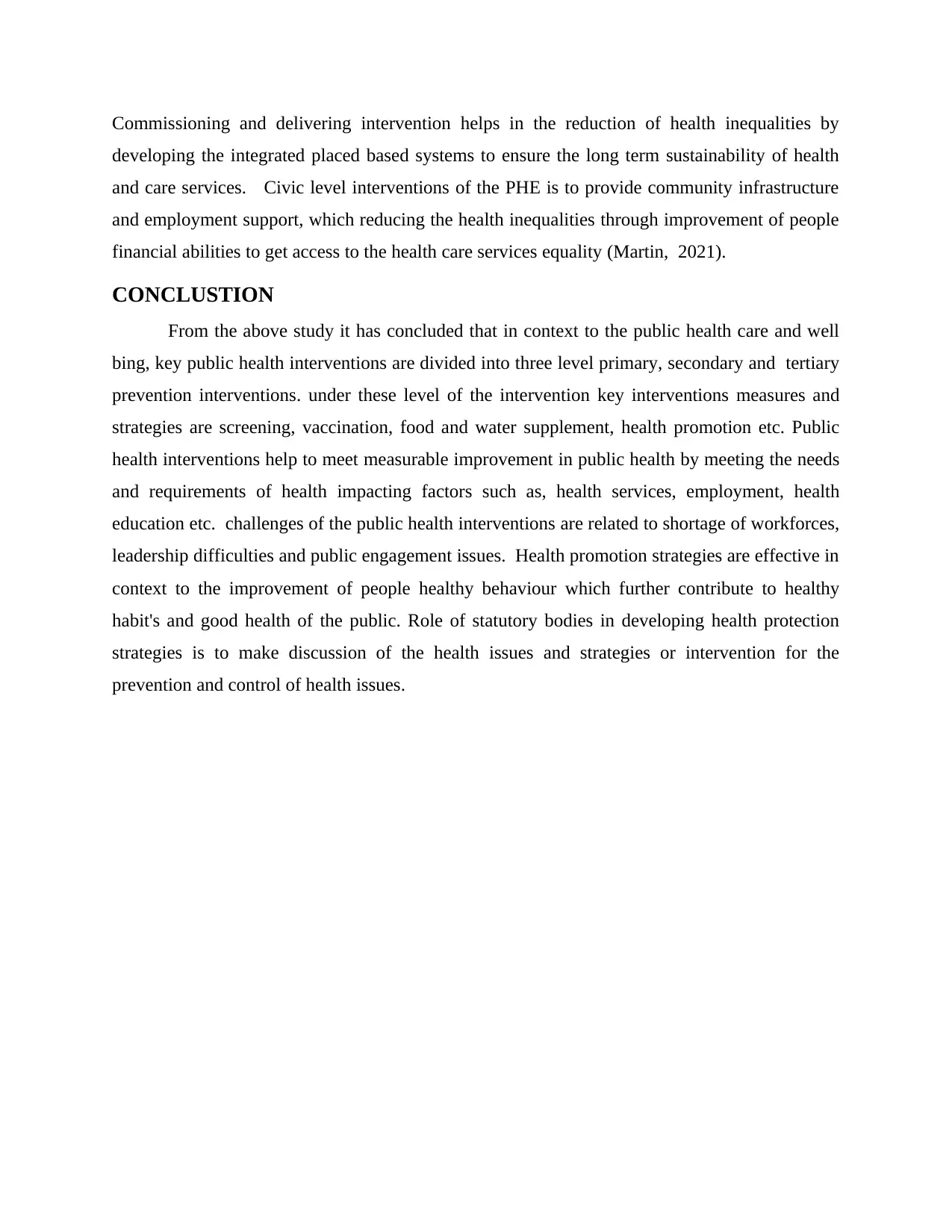
Commissioning and delivering intervention helps in the reduction of health inequalities by
developing the integrated placed based systems to ensure the long term sustainability of health
and care services. Civic level interventions of the PHE is to provide community infrastructure
and employment support, which reducing the health inequalities through improvement of people
financial abilities to get access to the health care services equality (Martin, 2021).
CONCLUSTION
From the above study it has concluded that in context to the public health care and well
bing, key public health interventions are divided into three level primary, secondary and tertiary
prevention interventions. under these level of the intervention key interventions measures and
strategies are screening, vaccination, food and water supplement, health promotion etc. Public
health interventions help to meet measurable improvement in public health by meeting the needs
and requirements of health impacting factors such as, health services, employment, health
education etc. challenges of the public health interventions are related to shortage of workforces,
leadership difficulties and public engagement issues. Health promotion strategies are effective in
context to the improvement of people healthy behaviour which further contribute to healthy
habit's and good health of the public. Role of statutory bodies in developing health protection
strategies is to make discussion of the health issues and strategies or intervention for the
prevention and control of health issues.
developing the integrated placed based systems to ensure the long term sustainability of health
and care services. Civic level interventions of the PHE is to provide community infrastructure
and employment support, which reducing the health inequalities through improvement of people
financial abilities to get access to the health care services equality (Martin, 2021).
CONCLUSTION
From the above study it has concluded that in context to the public health care and well
bing, key public health interventions are divided into three level primary, secondary and tertiary
prevention interventions. under these level of the intervention key interventions measures and
strategies are screening, vaccination, food and water supplement, health promotion etc. Public
health interventions help to meet measurable improvement in public health by meeting the needs
and requirements of health impacting factors such as, health services, employment, health
education etc. challenges of the public health interventions are related to shortage of workforces,
leadership difficulties and public engagement issues. Health promotion strategies are effective in
context to the improvement of people healthy behaviour which further contribute to healthy
habit's and good health of the public. Role of statutory bodies in developing health protection
strategies is to make discussion of the health issues and strategies or intervention for the
prevention and control of health issues.
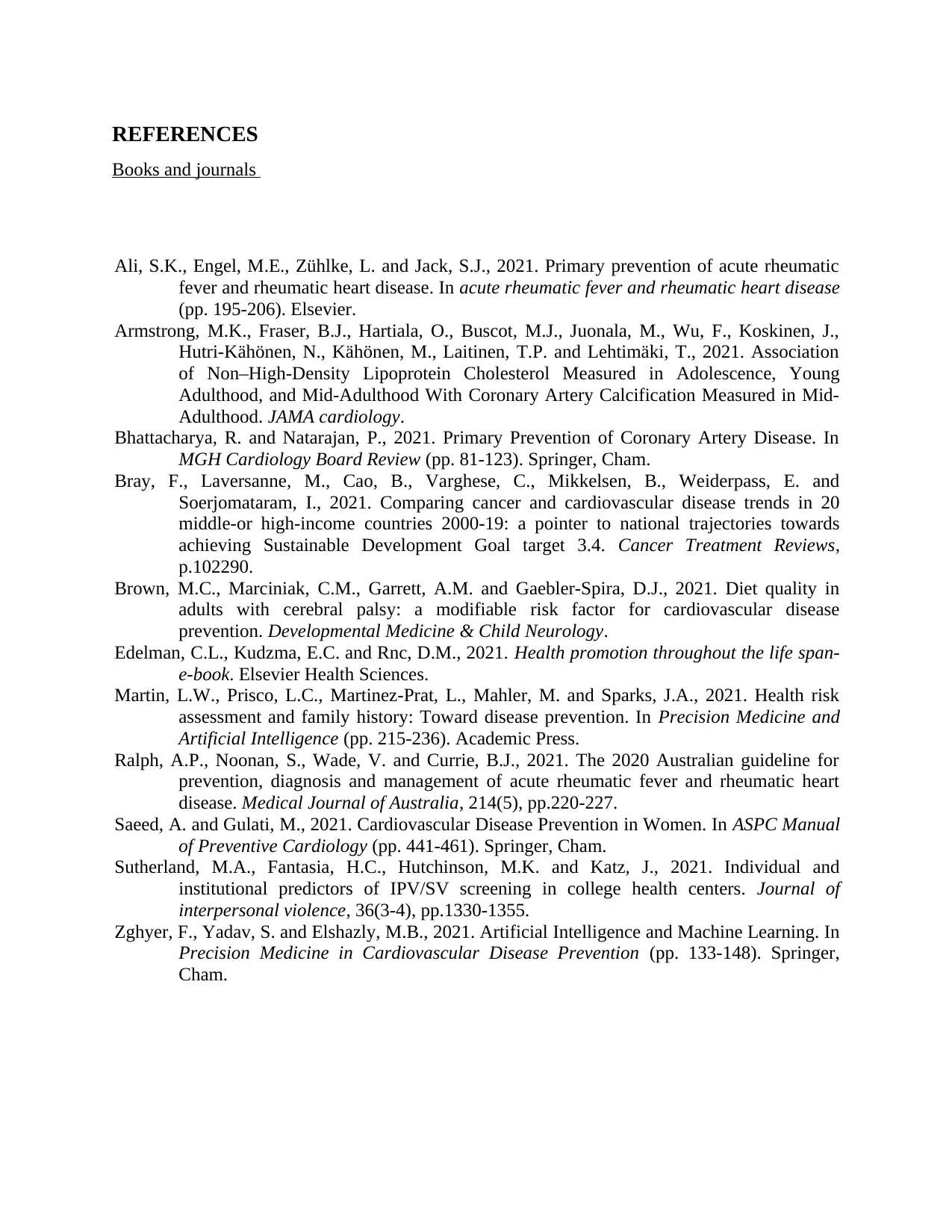
REFERENCES
Books and journals
Ali, S.K., Engel, M.E., Zühlke, L. and Jack, S.J., 2021. Primary prevention of acute rheumatic
fever and rheumatic heart disease. In acute rheumatic fever and rheumatic heart disease
(pp. 195-206). Elsevier.
Armstrong, M.K., Fraser, B.J., Hartiala, O., Buscot, M.J., Juonala, M., Wu, F., Koskinen, J.,
Hutri-Kähönen, N., Kähönen, M., Laitinen, T.P. and Lehtimäki, T., 2021. Association
of Non–High-Density Lipoprotein Cholesterol Measured in Adolescence, Young
Adulthood, and Mid-Adulthood With Coronary Artery Calcification Measured in Mid-
Adulthood. JAMA cardiology.
Bhattacharya, R. and Natarajan, P., 2021. Primary Prevention of Coronary Artery Disease. In
MGH Cardiology Board Review (pp. 81-123). Springer, Cham.
Bray, F., Laversanne, M., Cao, B., Varghese, C., Mikkelsen, B., Weiderpass, E. and
Soerjomataram, I., 2021. Comparing cancer and cardiovascular disease trends in 20
middle-or high-income countries 2000-19: a pointer to national trajectories towards
achieving Sustainable Development Goal target 3.4. Cancer Treatment Reviews,
p.102290.
Brown, M.C., Marciniak, C.M., Garrett, A.M. and Gaebler‐Spira, D.J., 2021. Diet quality in
adults with cerebral palsy: a modifiable risk factor for cardiovascular disease
prevention. Developmental Medicine & Child Neurology.
Edelman, C.L., Kudzma, E.C. and Rnc, D.M., 2021. Health promotion throughout the life span-
e-book. Elsevier Health Sciences.
Martin, L.W., Prisco, L.C., Martinez-Prat, L., Mahler, M. and Sparks, J.A., 2021. Health risk
assessment and family history: Toward disease prevention. In Precision Medicine and
Artificial Intelligence (pp. 215-236). Academic Press.
Ralph, A.P., Noonan, S., Wade, V. and Currie, B.J., 2021. The 2020 Australian guideline for
prevention, diagnosis and management of acute rheumatic fever and rheumatic heart
disease. Medical Journal of Australia, 214(5), pp.220-227.
Saeed, A. and Gulati, M., 2021. Cardiovascular Disease Prevention in Women. In ASPC Manual
of Preventive Cardiology (pp. 441-461). Springer, Cham.
Sutherland, M.A., Fantasia, H.C., Hutchinson, M.K. and Katz, J., 2021. Individual and
institutional predictors of IPV/SV screening in college health centers. Journal of
interpersonal violence, 36(3-4), pp.1330-1355.
Zghyer, F., Yadav, S. and Elshazly, M.B., 2021. Artificial Intelligence and Machine Learning. In
Precision Medicine in Cardiovascular Disease Prevention (pp. 133-148). Springer,
Cham.
Books and journals
Ali, S.K., Engel, M.E., Zühlke, L. and Jack, S.J., 2021. Primary prevention of acute rheumatic
fever and rheumatic heart disease. In acute rheumatic fever and rheumatic heart disease
(pp. 195-206). Elsevier.
Armstrong, M.K., Fraser, B.J., Hartiala, O., Buscot, M.J., Juonala, M., Wu, F., Koskinen, J.,
Hutri-Kähönen, N., Kähönen, M., Laitinen, T.P. and Lehtimäki, T., 2021. Association
of Non–High-Density Lipoprotein Cholesterol Measured in Adolescence, Young
Adulthood, and Mid-Adulthood With Coronary Artery Calcification Measured in Mid-
Adulthood. JAMA cardiology.
Bhattacharya, R. and Natarajan, P., 2021. Primary Prevention of Coronary Artery Disease. In
MGH Cardiology Board Review (pp. 81-123). Springer, Cham.
Bray, F., Laversanne, M., Cao, B., Varghese, C., Mikkelsen, B., Weiderpass, E. and
Soerjomataram, I., 2021. Comparing cancer and cardiovascular disease trends in 20
middle-or high-income countries 2000-19: a pointer to national trajectories towards
achieving Sustainable Development Goal target 3.4. Cancer Treatment Reviews,
p.102290.
Brown, M.C., Marciniak, C.M., Garrett, A.M. and Gaebler‐Spira, D.J., 2021. Diet quality in
adults with cerebral palsy: a modifiable risk factor for cardiovascular disease
prevention. Developmental Medicine & Child Neurology.
Edelman, C.L., Kudzma, E.C. and Rnc, D.M., 2021. Health promotion throughout the life span-
e-book. Elsevier Health Sciences.
Martin, L.W., Prisco, L.C., Martinez-Prat, L., Mahler, M. and Sparks, J.A., 2021. Health risk
assessment and family history: Toward disease prevention. In Precision Medicine and
Artificial Intelligence (pp. 215-236). Academic Press.
Ralph, A.P., Noonan, S., Wade, V. and Currie, B.J., 2021. The 2020 Australian guideline for
prevention, diagnosis and management of acute rheumatic fever and rheumatic heart
disease. Medical Journal of Australia, 214(5), pp.220-227.
Saeed, A. and Gulati, M., 2021. Cardiovascular Disease Prevention in Women. In ASPC Manual
of Preventive Cardiology (pp. 441-461). Springer, Cham.
Sutherland, M.A., Fantasia, H.C., Hutchinson, M.K. and Katz, J., 2021. Individual and
institutional predictors of IPV/SV screening in college health centers. Journal of
interpersonal violence, 36(3-4), pp.1330-1355.
Zghyer, F., Yadav, S. and Elshazly, M.B., 2021. Artificial Intelligence and Machine Learning. In
Precision Medicine in Cardiovascular Disease Prevention (pp. 133-148). Springer,
Cham.
⊘ This is a preview!⊘
Do you want full access?
Subscribe today to unlock all pages.

Trusted by 1+ million students worldwide

1 out of 10
Related Documents
Your All-in-One AI-Powered Toolkit for Academic Success.
+13062052269
info@desklib.com
Available 24*7 on WhatsApp / Email
![[object Object]](/_next/static/media/star-bottom.7253800d.svg)
Unlock your academic potential
Copyright © 2020–2025 A2Z Services. All Rights Reserved. Developed and managed by ZUCOL.





